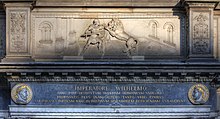Hermann Gryn
Hermann Gryn (also Grin ) is a fictional mayor of a Cologne legend , the story of which is said to have taken place in 1262.
The legend of Mayor Gryn
According to this legend , Archbishop Engelbert II of Falkenburg is said to have owned a lion that was raised by his two canons . The mayor Gryn was in constant dispute with Archbishop Engelbert, as he tried to defend civil rights against the influence of the archbishopric.
The canons, who were good friends with the archbishop, invited the mayor to a banquet. Before dinner, the canons directed the conversation to the lion they had fasted and offered the mayor to see him. After opening the door, however, the canons pushed the mayor into the lion cage and immediately closed the door. The mayor wrapped his cloak around his arm, lunged with his sword at the leaping lion, thrust his armored arm into the open mouth and pierced the lion's heart. It is reported that the later King Rudolph I came to Cologne the next day and found out about the events. He had the two canons hung from a beam in the Pfaffenpforte .
The lion's head attached above the Pfaffenpforte refers to this legend, which symbolized the ongoing dispute between the city and the archbishop. According to chronicles from the late 15th century, this episode took place in 1262.
In honor of this courageous fictional mayor, the fight between Gryn and the lion was carved in stone on the facade of the arbor of Cologne city hall in 1573 . The actual mayor at that time was Richwin Gryn (1271-1272), whose family line belonged to the Cologne patriciate .
Origin and interpretation
Hermann Gryn (Grin) belonged to the Cologne patriciate and actually existed. Various Hermann Gryns of the widely ramified Gryn clan appeared in the history of Cologne. The first Hermann acted as a lay judge in 1218. There was a certain Herimannus Gryn, son of Ricolfus (Richolf) Gryn, as bailiff. Herimannus was a bailiff at the time of lay judge Johannes Overstolz (1230). Hermann Gyn testified to an alliance treaty with the Duke of Brabant in 1251. Hermann Gryn was mayor - in this spelling - obviously not, but - much later - around 1300 Marsilius Gryn. However, the historian Friedrich Everhard von Mering quotes from a directory of Cologne mayors from 1216 to 1396, according to which Ludowicus de Müllengaßen (Ludwig von der Mühlengasse) was listed in 1258 and Hermannus Greyn in 1262 as mayor. If this was a typographical or transcription error, Hermann Gryn would actually have been mayor at the time until 1267, when he was succeeded by Ludowicus Weis.
The legend can also be related to the fact that Hermann von Vitinghoven, a confidante of Archbishop Engelbert II, gathered the community in front of the town hall on June 8, 1262 to inform them that the archbishop wanted to appoint one of the mayors and a lay judge himself from now on . In addition, the archbishop demands the delivery of food and a property tax. The angry citizens took up arms and fought against the archbishop's people.
The lion fight is a symbol of the ongoing conflict between the city and the archbishop, which reached its climax at the time of Archbishop Engelbert II. One possible explanation for the origin of the legend is that the influential Gryn family, which belonged to the legendary 15 Roman families of senatorial nobility settled by Emperor Trajan in Cologne, just like Engelbert had the lion in their coat of arms . In addition, there is evidence of a Roman sculpture in Cologne depicting the fight between Hercules and the lion, as well as two lion heads walled into the Pfaffenpforte.
Web links
- Julia Ricker: The lion to eat , Monuments Online 1.2012
Individual evidence
- ^ Philipp von Steinau, Die Volkssagen der Deutschen , 1838, p. 35
- ^ Johann Georg Theodor Grasse, Book of Legends of the Prussian State , Volume 2, 1871, p. 74
- ↑ Yearbook of the Roman-Germanic Central Museum Mainz, Volume 2 / Volume 50, 2004, p. 400
- ↑ Manfred Groten, Cologne in the 13th century , 1998, p. 125
- ↑ Dietrich Poeck, Rituale der Ratswahl , 2003, p. 45 (FN 257)
- ↑ Friedrich Everhard von Mering / Ludwig Reischert, On the history of the city of Cologne on the Rhine: from its foundation to the present , Volume 2, 1838, p. 204 (FN)
- ↑ Cologne and Bonn with their surroundings , 1828, p. 35

